Tabasco Style Fermented Hot Sauce
August 21, 2014 | Updated June 06, 2022
As an Amazon Associate I earn from qualifying purchases.
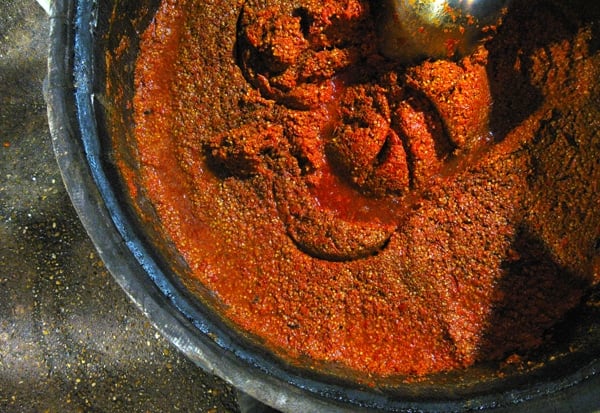
I am a Tabasco man, always have been. Sure, I love lots of hot sauces, but for me the alpha and omega of pepper sauce is Tabasco. What I didn’t know until I visited their plant was that it is a fermented hot sauce.
This slow fermentation makes sauces like Tabasco something more than just heat and vinegar, something more refined and mellow. I had no idea what that something was until I got a chance to visit Avery Island, Louisiana, and meet the McIlhenny family face to face.
Touring the plant, I was shocked to learn that the recipe for Tabasco is not some closely guarded secret. They’ll gladly tell anyone who asks what it is: Tabasco peppers, 2 1/2 percent salt, vinegar… and time. Lots of time. Winemaker-style time. Tony Simmons, the company’s CEO, walked me through it.
The Tabasco chiles are chopped up, mixed with salt mined right from the island itself, then poured into old oak barrels to ferment in a barn for up to five years, although most of the mash is fermented only (!) three years.
They then mix the mash with distilled vinegar (they used to use white wine vinegar) and let this pickle for a month, mixing all the way. Finally, they strain out the pulp and seeds and bottle the sauce.
I was fascinated by this. Aged in oak? For three years?! Damn. Gauntlet thrown. One I will gladly pick up.
Two years later, here’s how it went.
I decided to not even try to replicate Tabasco Sauce exactly, because why would I want to? Even if I succeeded, I can buy the stuff easier at the supermarket. I’d use the method, with different chiles, to make my own fermented hot sauce. Rather, two sauces: One red, one green.
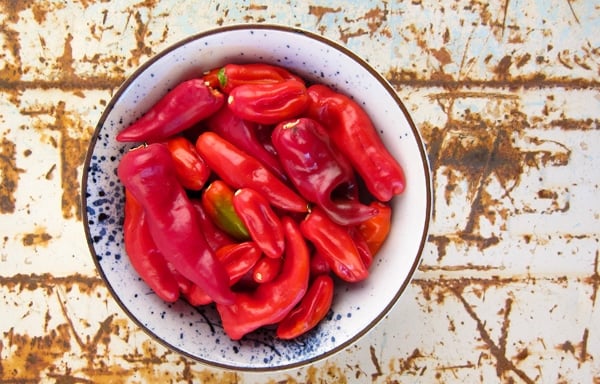
I grew a lot of chiles that year, so I used an eclectic mix of serranos, Tabascos, ripe padron chiles, and a few Thai chiles tossed in for good measure. Yes, I know doing this makes this sauce unrepeatable, but so be it. No vintage of a wine is exactly repeatable either, and since fermented hot sauce keeps almost as long as wine, it’d be fun to play with annual vintages.
I waited until late September 2012 to harvest all my chiles, and I grabbed both the red and green.
I stemmed them all and chopped them roughly, then tossed them in a food processor with that critical 2 1/2 percent salt — this is enough to protect the chiles from bad bacteria but not enough to prevent fermentation by the good bugs.
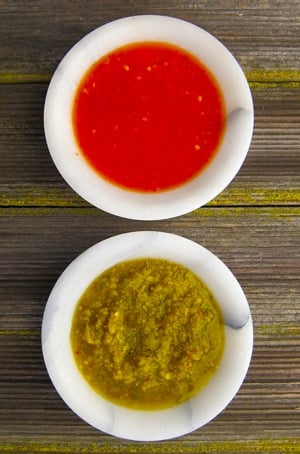
Into quart Mason jars they all went. Within a day they were fermenting, with an acrid, slightly yeasty smell that was something like a cross between Mace and a loaf of bread. Not that unpleasant, actually. I stirred the mash every day and let it breathe. After about 10 days things settled down, so I moved the jars into my salami fridge, which is a cool 55°F. But before I did that, I grabbed some toasted oak cubes I had from winemaking and tossed them in. Instant oak barrel!
And then I forgot about my hot sauce. For two full years. OK, that’s not totally true. Every few months or so I’d check on them, and once in a while a film of mold would grow on the surface; this happened three times. I just picked it off and called it good. After all, we’re dealing with chiles and salt here, both of which are pretty inhospitable ingredients to any truly bad wee beasties.
Finally, earlier this year I decided to make my sauce. I stared at that awesomely fermented mash, which was at once mellow and smooth yet muy picante, if such a thing can exist. I just couldn’t discard it. So I pureed it even smoother and added a little xanthan gum to stabilize it.
The result is a lovely hot sauce. Tangy from the fermentation, hot but not overbearing (a result of the mix of chiles I used), vinegary and a bit salty. It’s not Tabasco. It’s something different. Something… better? Perish the thought.
Fermented, Tabasco-Style Hot Sauce
Ingredients
- 3 1/3 pounds chile peppers, about 1.5 kilos
- 1 ounce kosher salt, about 37 grams
- 2 cups water
- 3 ounces oak cubes
- 4 cups white wine vinegar
- 1 teaspoon xanthan gum (optional)
Instructions
- Roughly chop the chiles and compost the stems. Blitz the chiles in a food processor or blender with the salt and water until you get a rough paste or slurry, depending on how much moisture there is in the peppers themselves. I keep the seeds in the chiles, but if you want a milder sauce, remove them.
- Put the mash into quart mason jars and cap them loosely. "Burp" the caps at least once a day to let out escaping gases and let air in. The chiles will ferment like this for at least a week, and sometimes up to 3 weeks. When the chiles settle down, add the oak cubes, distributing them evenly throughout the jars. Tighten the lids and store the jars in a cool, dark place. I kept mine in my salami fridge, which is 55°F. A basement is fine, as would a fridge. Tabasco keeps their mash barrels at ambient temperatures, which in Louisiana can top 100°F. I am working on a batch fermented this way now, and I see no reason it won't work. Don't let the mash freeze, however.
- Keep the mash like this no less than 3 months, and up to 2 years. When you are ready to finish the sauce, mix the mash with the vinegar.
- You now have two choices: You can do what Tabasco does and return the mix to the jars, shake them every day for a month and then strain out the pulp and seeds. Or, do what I do and keep all that pulp, which will give the sauce body and thickness. If you choose my method, you will need to really blend the sauce and stabilize it -- otherwise the sauce will eventually separate and will need to be shaken up before each use. To do so, dissolve the xanthan gum in 2 tablespoons of water and add it to the blender. Blend for a solid minute. Let the sauce rest for 1 hour before bottling so any trapped air in sauce (from the blending process) can escape. Bottle and store. The sauce will keep for a year or more.
Notes
Nutrition information is automatically calculated, so should only be used as an approximation.
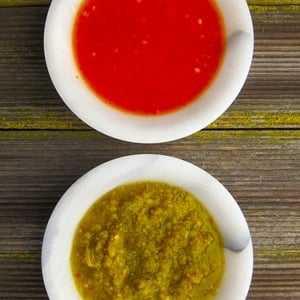
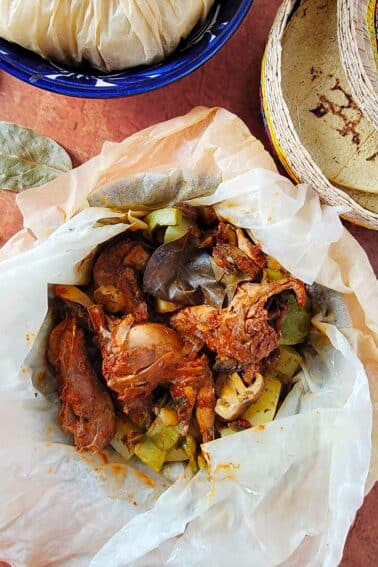

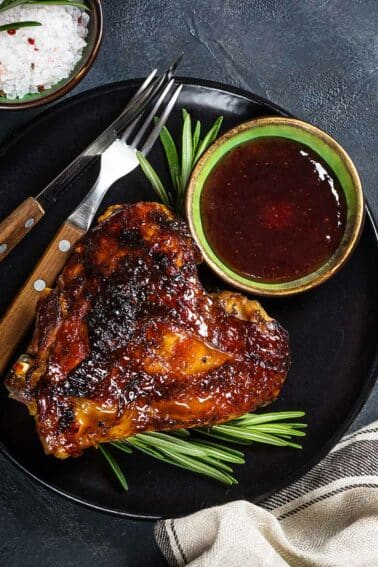
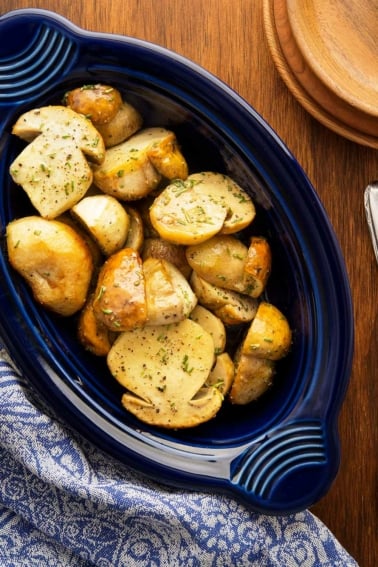
Looking for clarification…you state that the critical salt ratio is 2.5%, per Tabasco. Then you say to remember the key ratio of 2%. You’re recipe uses roughly 2%. What happened to the other .5% or did I miss something? Thanks!
Jason: Sorry about that. You have wiggle room. I prefer 2%, but I’ve seen it as low as 1.5% and as high as 3%. Tabasco itself uses 2.5%.
Hank,
With your recipe, how much liquid (separate from pulp) does this yield?
Al
Al: I puree it all in a blender, so however much that is. The only thing I measure is salt by weight. Every batch is different in terms of chiles + water.
Hank, my pepper mash is fermenting currently but it has separated quite a bit, most of the water is at the bottom and the thick mash is on top. Is this normal?
G.S. Yep, totally normal.
A few years ago when we had a bumper crop of hot peppers including Tabascos, Habaneros, Vietnamese, and many others, I bought one of those little aging kegs on amazon, filled it with Moonshine for 2 weeks (Tabasco uses Jack Daniels kegs, but we’re in West Virginia… 🙂 put the pepper-salt mash in the keg, and totally forgot about it for 3 years. It was THE best hot sauce we’ve ever had in our LIVES! And, as you said, inimitable! I Highly recommend doing that if you have a bumper crop of peppers! This year, with only a couple of bowlfuls of peppers, I am fermenting the mash in brine in a Mason Jar- and will dole it out like a controlled substance for the next year!
Hi have been making a similar recipe for 10 uears . But have always used only 15ml viniger per litre of mash once fermentation is finished usually 3 mnths. I would like to sell this comercially at markets but have found that when left out the fridge for a few hours it does build up co2 in the jars. So you get a pop sound when opening the jar. Is there a way of preventing this gas build up…..or could it he a health risk????
Dino: Then it is still fermenting. You need to wait until the ferment is done. The vinegar helps stop it.
Mr Shaw, after i use your recepe for 2 years i would like to comment that it is a simple but with great potential for experiment recipe. I have made several experiments with different recipes but this one gives the most satisfying results. It happened that i found a pepper plant that had some chillies that smell and taste exactly like tabasco ( but are a bit smaller than those in your pictures) so i started to grow my own “breed”. I will try them your way and when i get my results i will let you know.
Thanks for the great recipe.
I made this in Jan 2019 using cherry bomb peppers. Since I had some wood chips for smoking I toasted those in my oven and put them into a tea bag, then into the ferment. It’s now July and I just scraped off about an inch of mold and blended everything underneath (that still looked and smelled great!). I strained it after blending and now have an amazing hot sauce! I just went and bought a variety of peppers to make it again. So good!
I just poured my fermented hot pepper sauce out of an oak barrel I had purchased for the experiment. I put it in the barrel on 9/28/18. I was so excited, and am now horrified to have found a big blob of black mold. Makes me want to shed a tear, and not because of the Scovilles. Waah! Next year I use your oak block idea and put it in a container I can look in.
Well, Hank. I have been making hot sauce for three years now. I found your article here about the Tabasco brand and the faux method of trying to imitate it. It was a huge success and I thank you for the tidbits of advice. I have a huge garden and grow all kinds of things. Mostly I like peppers! Sweet ones and hot ones alike. I grow a variety of heirloom pepper that I call paprika pepper (a heavy walled sweet yet hot pepper) and also make smoked paprika. Back to the hot sauce. I used three kinds of peppers in my toasted oak batch, I toasted my own white oak pieces too. I used 50% Hungarian, 25% Portugal and 25% jalapenos (red ripe). I pretty much did as you except I used a dark cooler closet instead of a fridge. My three months were up and I finished processing it. Simply amazing stuff thank you! it has a very unique flavor and it is so mellow. The heat is fairly warm and am not going to try and rate the Scoville number but I will say this. The flavor will make even the heat naysayers ask for more. I witnessed this several times and have made new hot sauce fans of some.
Do you strain out the water before you add the vinegar or just keep them all together?
Josh: I tend to strain off a lot of it, but some is OK. You want a sauce with a little body, but not so thick as, say A1 Sauce. Unless of course that’s what you like. Then go for it! It’s just that Tabasco is a thinner sauce.
Hank- do you think it would be safe to keep the mash in the quart jars at room temperature, and not in a refrigerator like you do? I don’t have refrigerator room. After reading what the Tabasco company does, it would seem alright PS-thank you for answering my other questions.
Donna: I think it will be fine, but you might get more mold to skim off.
Hank,
You start your story saying Tabasco uses 2 & 1/2 % salt but your recipe calls for 2 %, I use 2% in my sauerkraut, why the difference ?
Bob: I prefer 2% as you get a more fermented flavor.
Hank- do you know a good source for gallons of white wine vinegar? It is too expensive on Amazon and places like GFS food service stores just carry the red wine vinegar.
Hello, can you tell me where to find oak cubes and xanthan gum? Also, at the end where you can strain out the pulp and seeds, or blend as you do, how do you blend and completely break down the seeds? Wouldn’t there be a grittiness to the hot sauce because of the seeds? Sorry for all the questions! I just have one bag of tabasco style chilis from the garden that I want to use and that is all I have. Don’t want to mess this up!
Donna: Oak cubes and xanthan gum on Amazon, and I blend everything completely, seeds and all. But I have a badass blender… 😉
Does water need to be added periodically for long term fermentation? I assume there must be some evaporation.
Guillermo: Nope. But you would if you did not limit fermentation.
Hey Hank,
I’m kind of a newb at this. Can this recipe be proportionately decreased or increased? I want to use the peppers from my garden and I don’t have 3.5 pounds.
Thanks!
Timmy: Absolutely. You can scale up or down as needed.
I recently made a batch but was unable to burp the jars after the first three days. When I returned home there was mold on top. You mentioned removing the mold and continuing. My concern is how much mold is acceptable. A skin on the top or a few specks?
Barb: I get a skin that I skim off every week or two.
Hi, Hank – I really like what you did here, and intend to try it or something similar.
I had one question: your write-up mentions 2.5% salt, while the recipe says 2%; is that a range, or would one number be better than the other?
Thanks –
Ron
Ron: It’s a range. If you are planning on fermenting it for a long long time, go with the higher amount of salt.
I have a fermentation jar with a one-way valve in the lid to let gases out, used for making fermented pickles. Would that work?
John: Yes it would.
Ok I don’t have 3 lbs of pepper. I can get the 2% salt easy enough but how much water do I put in?
Lonnie: Just enough to make a paste.